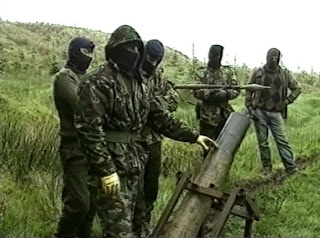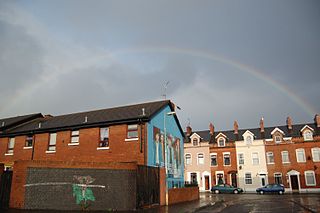
The Troubles were an ethno-nationalist conflict in Northern Ireland that lasted for about 30 years from the late 1960s to 1998. Also known internationally as the Northern Ireland conflict, it is sometimes described as an "irregular war" or "low-level war". The conflict began in the late 1960s and is usually deemed to have ended with the Good Friday Agreement of 1998. Although the Troubles mostly took place in Northern Ireland, at times violence spilled over into parts of the Republic of Ireland, England, and mainland Europe.

The East Tyrone Brigade of the Provisional Irish Republican Army (IRA), also known as the Tyrone/Monaghan Brigade was one of the most active republican paramilitary groups in Northern Ireland during "the Troubles". It is believed to have drawn its membership from across the eastern side of County Tyrone as well as north County Monaghan and south County Londonderry.

The Irish People's Liberation Organisation was a small Irish socialist republican paramilitary organisation formed in 1986 by disaffected and expelled members of the Irish National Liberation Army (INLA), whose factions coalesced in the aftermath of the supergrass trials. It developed a reputation for intra-republican and sectarian violence as well as criminality, before being forcibly disbanded by the Provisional Irish Republican Army (IRA) in 1992.

The Milltown Cemetery attack took place on 16 March 1988 at Milltown Cemetery in Belfast, Northern Ireland. During the large funeral of three Provisional IRA members killed in Gibraltar, an Ulster Defence Association (UDA) member, Michael Stone, attacked the mourners with hand grenades and pistols. He had learned there would be no police or armed IRA members at the cemetery. As Stone then ran towards the nearby motorway, a large crowd chased him and he continued shooting and throwing grenades. Some of the crowd caught Stone and beat him, but he was rescued by the police and arrested. Three people were killed and more than 60 wounded.

From 1969 until 1997, the Provisional Irish Republican Army (IRA) conducted an armed paramilitary campaign primarily in Northern Ireland and England, aimed at ending British rule in Northern Ireland in order to create a united Ireland.

Operation Banner was the operational name for the British Armed Forces' operation in Northern Ireland from 1969 to 2007, as part of the Troubles. It was the longest continuous deployment in British military history. The British Army was initially deployed, at the request of the unionist government of Northern Ireland, in response to the August 1969 riots. Its role was to support the Royal Ulster Constabulary (RUC) and to assert the authority of the British government in Northern Ireland. This involved counter-insurgency and supporting the police in carrying out internal security duties such as guarding key points, mounting checkpoints and patrols, carrying out raids and searches, riot control and bomb disposal. More than 300,000 soldiers served in Operation Banner. At the peak of the operation in the 1970s, about 21,000 British troops were deployed, most of them from Great Britain. As part of the operation, a new locally-recruited regiment was also formed: the Ulster Defence Regiment (UDR).
The Ballygawley bus bombing was a roadside bomb attack by the Provisional Irish Republican Army (IRA) on a bus carrying British soldiers in Northern Ireland. It occurred in the early hours of 20 August 1988 in the townland of Curr near Ballygawley, County Tyrone. The attack killed eight soldiers and wounded another 28. In the wake of the bombing, the British Army began ferrying its troops in and out of County Tyrone by helicopter.
This is a chronology of activities by the Provisional Irish Republican Army (IRA) from 1980 to 1989. For actions before and after this period see Chronology of Provisional Irish Republican Army actions.
This is a chronology of activities by the Provisional Irish Republican Army (IRA), from 1992 to 1999.

From 6 to 11 July 1997 there were mass protests, fierce riots and gun battles in Irish nationalist districts of Northern Ireland. Irish nationalists/republicans, in some cases supported by the Provisional Irish Republican Army (IRA), attacked the Royal Ulster Constabulary (RUC) and British Army. The protests and violence were sparked by the decision to allow the Orange Order to march through a Catholic/nationalist neighbourhood of Portadown. Irish nationalists were outraged by the decision and by the RUC's aggressive treatment of those protesting against the march. There had been a bitter dispute over the march for many years.

On 5 February 1992, there was a mass shooting at the Sean Graham bookmaker's shop on the Lower Ormeau Road in Belfast, Northern Ireland. Members of the Ulster Defence Association (UDA), a loyalist paramilitary group, opened fire on the customers with an assault rifle and handgun, killing five civilians and wounding nine. The shop was in a Catholic and Irish nationalist area and all of the victims were local Catholics. The UDA claimed responsibility using the cover name "Ulster Freedom Fighters", saying the shooting was retaliation for the Teebane bombing, which had been carried out by the Provisional IRA less than three weeks before. A later investigation by the Police Ombudsman found that the Royal Ulster Constabulary (RUC) had engaged in "collusive behaviour" with UDA informers involved in the attack.
The Troubles in Ardoyne lists incidents during the Troubles in the Ardoyne district of Belfast, Northern Ireland.

The Hillcrest Bar bombing, also known as the "Saint Patrick's Day bombing", took place on 17 March 1976 in Dungannon, County Tyrone, Northern Ireland. The Ulster Volunteer Force (UVF), a loyalist paramilitary group, detonated a car bomb outside a pub crowded with people celebrating Saint Patrick's Day. Four Catholic civilians were killed by the blast—including two 13-year-old boys standing outside—and almost 50 people were injured, some severely.

In the late hours of 3 February and the early hours of 4 February 1973, six men, all of whom were Catholics, were shot and killed in the New Lodge area of north Belfast:
The following is a timeline of actions during The Troubles which took place in the Republic of Ireland between 1969 and 1998. It includes Ulster Volunteer Force bombings such as the Dublin and Monaghan bombings in May 1974, and other loyalist bombings carried out in the 1970s, '80s and '90s, the last of which was in 1997. These attacks killed dozens of people and injured hundreds more. Also actions carried out by Irish republicans including bombings, prison escapes, kidnappings, and gun battles between the Gardaí (police) and the Irish Defence Forces against Republican gunmen from the Irish National Liberation Army, the Provisional Irish Republican Army, and a socialist-revolutionary group, Saor Éire. These attacks killed a number of civilians, police, soldiers, and republican paramilitaries.

The Irish National Liberation Army Belfast Brigade was the main brigade area of the Irish National Liberation Army (INLA). The other Brigade areas were in Derry which was split between two battalions, the first in Derry City, and the second battalion in south County Londonderry and County Armagh which was also split into two battalions, a south Armagh and a north Armagh battalion, with smaller units in Newry, east and west County Tyrone and south County Fermanagh.
This is a timeline of actions by the Official Irish Republican Army, an Irish republican & Marxist-Leninist paramilitary group. Most of these actions took place as part of a Guerrilla campaign against the British Army & Royal Ulster Constabulary and internal Irish Republican feuds with the Provisional IRA & Irish National Liberation Army from the early 1970s - to the mid-1970s during the most violent phase of "the Troubles" in Northern Ireland.
The following is a Timeline of British Army and Royal Ulster Constabulary (RUC) undercover operations during Operation Banner during the 1969 – 1998 Northern Irish conflict in Northern Ireland that resulted in death or injury. Including operations by the SAS, 14 Intelligence Company, the Military Reaction Force (MRF), RUC Special Patrol Group and Special Branch.
This is a chronology of activities by the Provisional Irish Republican Army (IRA), in 1990 and 1991.












